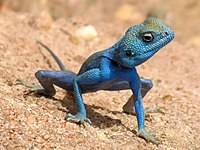
An unidentified tree frog from the
Congo with warning coloration. Certainly it is poisonous

The
skunk is an example of mammalian aposematism.

Gregarious nymphs of an aposematic
milkweed bug,
Lygaeus kalmii: by keeping together they make their warning more visible

This, though very conspicuous, is not warning coloration. It is a male
lizard,
Agama sinaita, Jordan, near the
Red Sea. While in heat, the male turns striking blue to attract females. Its color is therefore a
secondary sex characteristic.

Crimson Speckled Moth: the function of its color is not known, perhaps aposematic. The hind wings are different, and more normal.
Warning coloration (or aposematism) is how animals let other animals know that they are poisonous or dangerous. It is the exact opposite of camouflage. Warning colors are usually some combination of red, yellow, black and white.
Alfred Russel Wallace, a British naturalist, explained it this way, in 1889:
- "The animals in question are possessors of some deadly weapons, as stings or poison fangs, or they are uneatable, and are thus so disagreeable to the usual enemies of their kind that they are never attacked when their peculiar powers or properties are known.
It is, therefore, important that they should not be mistaken for defenceless [sic] or eatable species... since they might suffer injury, or even death, before their enemies discovered the danger or uselessness of their attack. They require some signal or danger flag which shall serve as a warning to would-be enemies..."
Wallace predicted that birds and other predators would reject conspicuous prey whilst accepting cryptic prey. Later reports confirmed this.



